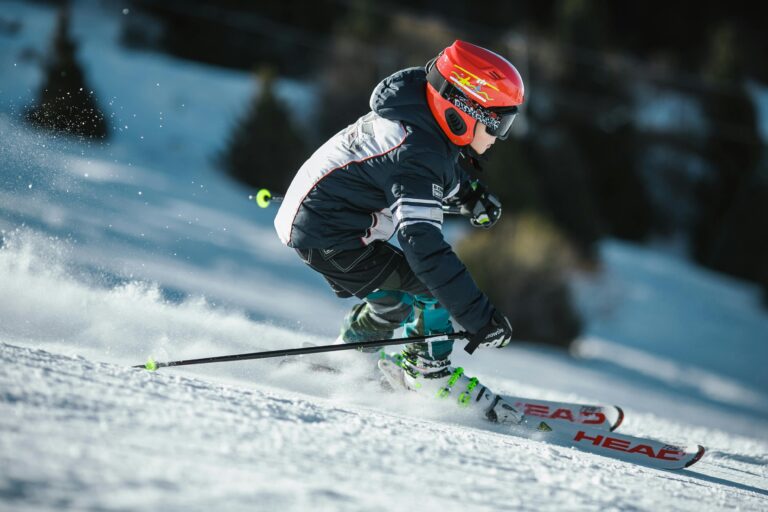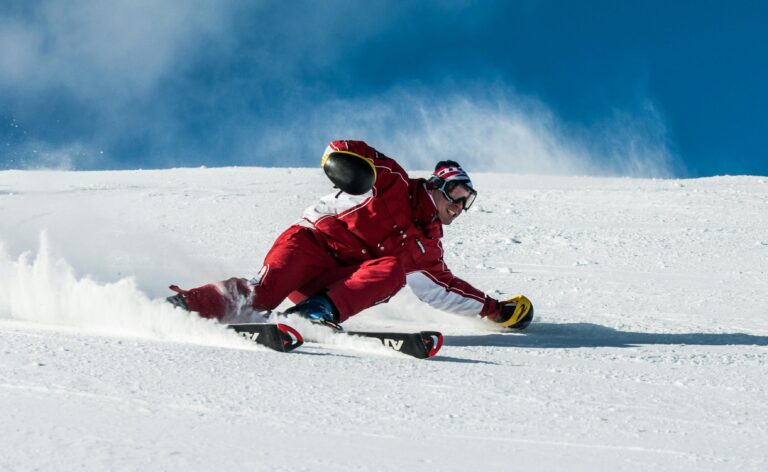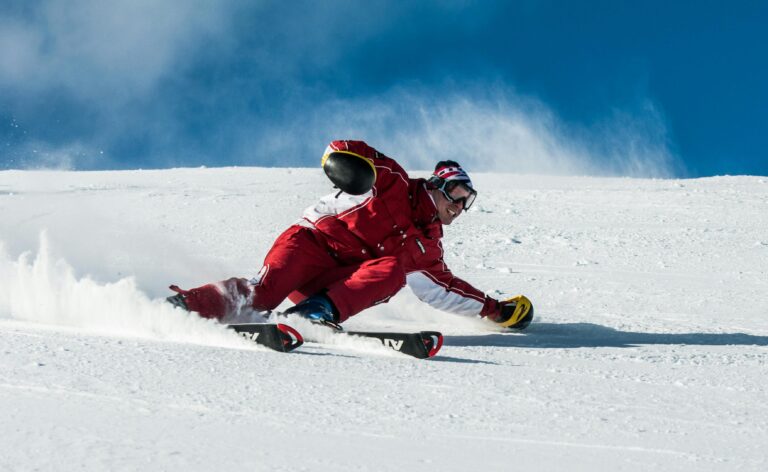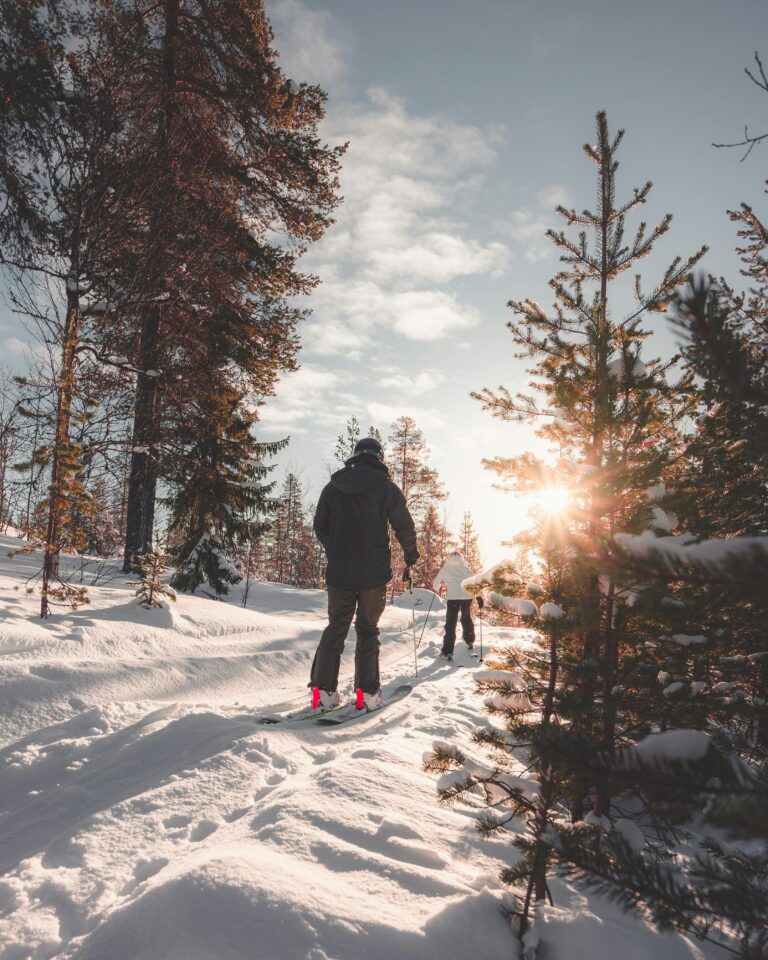“`json
{
“blogcontent”: “
Understanding the Risks of High-Speed Winter Sports: The Reality of Snowboarding
When you think about winter sports, what comes to mind? For many, it’s the exhilarating feeling of zipping down snow-covered slopes on a snowboard. It’s hard not to feel that rush of excitement gliding through fresh powder! But before you strap on your board and hit the slopes, let’s chat about the not-so-fun side of snowboarding: the risks that come along with it.
Defining the Risks
Snowboarding is like riding a roller coaster, full of thrills but with some risks of falling off the rails! The National Ski Areas Association reports that while snowboarding brings immense joy, it also has a significant injury rate. In fact, research shows that snowboarding can lead to about 17.7 injuries for every 1,000 riders. That’s a lot!
Common Injuries in Snowboarding
So, what kind of injuries are we talking about? Here’s a quick rundown of some of the more frequent ones:
- Sprains: These pesky injuries often happen when a rider falls and twists in an odd way, especially wrist sprains from trying to cushion the fall.
- Fractures: Ouch! Fractures, particularly in the wrist, collarbone, or legs, are a serious concern. A study from the British Journal of Sports Medicine tells us that falls contribute to about 56% of snowboarding injuries, with fractures being a major culprit.
- Contusions: These delightful bruises occur from direct impacts during falls. They’re not deadly but certainly not fun either.
- Head Injuries: While less common, these can be severe. Wearing a helmet can really save your noggin!
- Knee Injuries: Torn ligaments in the knee can happen due to those dramatic wipes out—especially during turns.
Analyzing the Impact on Different Riders
The risks of snowboarding are real, but they can look different based on who you are.
- Beginners: If you’re new to snowboarding, it’s vital to understand the risks. Knowing what to look out for can help you make safer choices—like learning how to fall correctly and investing in some safety gear. Surprisingly, only 35% of snowboarders actually wear helmets, despite their effectiveness!
- Parents: If you’re a parent thinking about letting your kids take up snowboarding, knowing the risks is a must. It can be an awesome way for them to stay active and enjoy the outdoors, but they’ll need your guidance. The National Institutes of Health says that discussing safety with kids can lead to better choices on the slopes.
- Experienced Riders: Even if you’ve hit the slopes dozens of times, it’s easy to let your guard down. Complacency can lead to accidents, so even pros need to keep safety at the forefront. Advanced riders should pay particular attention to how changing conditions can impact their ride.
Conclusion: A Call for Awareness and Preparedness
Snowboarding can be an incredibly liberating activity. It’s all about freedom and fun, but let’s not forget about the risks. Being aware of the potential injuries can go a long way in keeping everyone safe. As we prepare to ride, let’s make sure we’re priortizing our safety gear—every run should be about enjoying the thrill while keeping it safe!
So, are you ready to hit the slopes? Just remember: strap on your board, bring your helmet, and keep safety in mind. For more tips on snowboarding safety, check out resources from reputable organizations like the National Ski Areas Association or the British Journal of Sports Medicine.
The Hidden Dangers of Snowboarding: Injury Statistics and Comparisons
Let’s dive into the reality of snowboarding through the lens of numbers. Year after year, thousands of snowboarders race to enjoy the sports, but what do the statistics really tell us?
Understanding Snowboarding Injury Statistics
Each year, approximately 44,000 snowboarding-related injuries occur in the U.S. Crazy, right? This number can vary based on conditions, skill levels, and more!
- Males vs. Females: Statistically, about 59% of injuries happen to guys, highlighting the need for tailored safety practices for everyone.
- Age Groups: The most accident-prone gamers, err, riders, are typically between 15-24 years old, making up 45% of total injuries. This age group loves to push limits, often leading to adventures and… unfortunate crashes.
Types of Injuries
Injuries can range from being more like mosquito bites to something far worse:
- Minor Injuries: Think sprains and strains, which account for 39% of cases.
- Moderate Injuries: Fractures, especially in the wrist and shoulders, making up 45% of incidents.
- Severe Injuries: Head injuries, although less frequent, are the serious ones, accounting for about 16% and can lead to long-term issues.
Comparing Snowboarding with Other Sports
Let’s put snowboarding under the microscope and see how it stacks up against other wintertime fun like skiing and sledding.
Skiing
With skiing, the annual injury rate is about 50,000. However:
- Injuries: While both sports cause wrist and ankle injuries, skiing often leads to more knee injuries.
- Severity: Skiing accidents can be troubling, affecting mainly the knees. A shocking 47% of skiing injuries are designated as traumatic injuries.
Sledding
Now, here’s a surprising bit about sledding:
- With about 20,000 injuries a year, sledding seems safer. But head injuries spike at 30%, proving sledding is not as innocent as it looks.
- The kiddo demographic (ages 5-14) is most at risk, underscoring the need for adult supervision and helmets!
Summary of Comparative Data
| Sport | Annual Injuries | Major Injury Types | Demographics |
|---|---|---|---|
| Snowboarding | 44,000 | Wrist Fractures, Head Injuries | Ages 15-24, Mostly Male |
| Skiing | 50,000 | Knee Injuries, Fractures | Various ages, Mostly Adults |
| Sledding | 20,000 | Head Injuries, Sprains | Ages 5-14, Supervision Needed |
The Importance of Safety
These statistics are not just numbers; they are a call to action! By wearing helmets, gearing up, and being mindful of personal limits, we can reduce risks and enjoy the thrill of the slopes.
Snowboarding brings excitement, and enjoyment shouldn’t be overshadowed by fear. So remember, knowledge about risks is your best weapon for safety! If you need a refresher on snowboarding safety stats, dive deep with trusted sources!
Understanding Common Snowboarding Injuries & Their Causes
Snowboarding fuels our adrenaline and spirit, but it can also lead to injuries. Let’s explore some common ones and how best to avoid them.
Common Snowboarding Injuries
Here’s a closer look at the injuries snowboarders often face:
1. Wrist Fractures
Causes: They typically result when a rider falls and reaches out to stop, leading to painful fractures.
- Statistics: A study from the Sports Medicine Journal shows wrist injuries account for about 30% of all snowboarding injuries.
- Personal Account: Emily recalls, \”I thought I could handle that jump! Nope, shattered my wrist; I learned the hard way.\”
2. Shoulder Injuries
Causes: Like wrist fractures, shoulder injuries stem from hard falls, resulting in dislocations.
- Statistics: They account for approximately 15% of injuries.
- Experience: Mark lamented, \”The worst was dislocating my shoulder. That’s how you end a friendship with snowboarding for a season!\”
3. Knee Ligament Injuries
Causes: Awkward landings can lead to serious ligament injuries.
- Statistics: These injuries represent about 20% and can take a long time to heal.
- Experience: Sarah, an instructor, adds, \”Proper technique saves from knee injuries.\”
4. Ankle Sprains
Causes: Ankle sprains occur due to falls or catching an edge.
- Statistics: They account for 10% of injuries reported.
- Story Time: Jake recalls, “I caught an edge while speeding downhill. My poor ankle!”
5. Concussions
Causes: Concussions arise from hard hits, particularly from falling backward.
- Statistics: A concerning 5% of injuries lead to concussions.
- Testimonial: Lisa shares, \”Hit my head hard; dizziness lasted days. Now, I never snowboard without my helmet!\”
Mitigating Risks in Snowboarding
Though injuries occur, there are ways to lessen the odds. Here’s how:
- Wear Protective Gear: Helmets, wrist guards, and padded clothing can significantly minimize injury risks.
- Take Lessons: For beginners, professional instruction is crucial for building foundational skills.
- Practice Safe Techniques: Learn how to fall correctly and maintain proper posture to reduce injury chances.
Conclusion
Snowboarding offers exhilarating experiences but comes with risks. Understanding common injuries and their causes can help you prepare better for the slopes.
For further understanding of preventive measures, check out information from the Sports Medicine Journal and American Orthopaedic Society for Sports Medicine. Equip yourself with the right knowledge to safely tackle the thrill of snowboarding!
Essential Gear for Snowboarders: Stay Safe on the Slopes
So, you’re ready to conquer the slopes? Not so fast! Before you swoosh down the mountain, let’s chat about gear. Why? Because over 600,000 snowboarders get injured in the U.S. each year (yikes!). The right gear can make a world of difference!
Helmets: Your First Line of Defense
Think of your helmet as your superhero cape—totally essential!
Key Features to Consider:
- Fit: Make sure it fits snugly without being suffocating.
- Material: Look for strong outer shells and comfy inner linings. A little technology like MIPS can provide extra safety.
- Ventilation: Keep your head cool on slushy days!
Visual Guide: Helmet Types
- Full-Face Helmets: Great for extreme conditions.
- Traditional Helmets: A balanced choice for casual riders.
*For more on helmet safety, check out the National Ski Areas Association.
Wrist Guards: Protect Those Wrists!
Wrist injuries happen—often. They can be painful!
Benefits of Wrist Guards:
- Support: These helpful pieces of gear prevent hyperextension during falls.
- Padding: Comfortable cushion can make all the difference.
Studies indicate that wearing wrist guards can reduce wrist injuries by up to 50%. That’s a statistic you can’t ignore!
Pads: Protect What Matters
Knee and elbow pads are your safety net when you descend too quickly.
Why Invest in Knee and Elbow Pads?
- Cushioning for Impact: They can save you from a ouch-filled season.
- Flexibility: Modern pads are lightweight, so you can still look stylish while protecting yourself!
Visual Guide: Choosing the Right Pads
| Gear Type | Key Benefit | Recommended For |
|---|---|---|
| Knee Pads | Minimize impact in falls | All snowboarders |
| Elbow Pads | Prevent abrasion | Beginners especially |
| Impact Shorts | Extra protection during tricks | Freestyle riders |
Putting It All Together: A Safety Investment
Investing in safety gear gives you confidence as you ride. Remember: Try not to scrimp on gear. It’s like going into battle without armor!
Next time you gear up, don’t just think about style; consider how each piece will protect you. Trust me, your future self will thank you!
Tips on Progression and Choosing the Right Terrain: Best Practices for Learning Snowboarding
Snowboarding is thrilling, but it can also be overwhelming for beginners. If you’re just starting, you want to ensure you make safe choices while learning. Let’s get into some tips that will keep your snowboarding experience fun and safe!
Understanding Terrain for Beginners
Choosing the right slope can make or break your learning experience. Here are some pointers:
1. Start with Gentle Slopes
- Why? Beginners should stick to softer hills (green runs) that are easy to manage.
- Tip: Knowing the slope’s markings (green for easy, blue for intermediate, black for advanced) is a lifesaver!
2. Controlled Environments
- Resorts vs. Backcountry: A resort is ideal for new riders because it has dedicated beginner areas and helpful staff.
- Safe Learning Areas: Look for areas specifically designed for beginners—they often have friendly features like soft snow.
3. Favorable Weather Conditions
- Ideal Conditions: Snow that’s warm and soft is a beginner’s best friend. Icy snow? No, thanks!
- Check the Forecast: Always check what Mother Nature has in store before heading out.
Best Practices for Safe Learning
Safety matters in snowboarding, just as much as the fun! Here are some best practices:
1. Wear Proper Safety Gear
- A helmet is a must! Studies show it reduces head injuries significantly.
2. Take Lessons from Certified Instructors
- Professional instruction is key. Group lessons can provide valuable guidance while also being a blast!
3. Practice Falling Safely
- Learning to fall correctly can reduce injuries—try falling sideways or rolling instead of landing straight back.
4. Know How to Get Up Gracefully
- After a fall, use your knees to help you stand up. It’s much safer than using your hands (no broken wrists here!).
5. Stay Hydrated and Take Breaks
- Snowboarding can tire you out! Keep sipping water and take regular breaks so you don’t push too hard.
6. Recognize Your Limits
- It’s totally fine to take a step back if a slope feels daunting. Snowboarding is all about progression!
Conclusion: Enjoy the Ride
Snowboarding can be exhilarating and a great way to enjoy winter. However, keeping safety top of mind will lead to a better experience. So, take it slowly; start with gentle slopes, wear your gear, and learn at your own pace!
Embrace the adventure ahead, and let the snow-filled fun begin!
Analyzing Risk Perception and Injury Rates Among Snowboarders
When it comes to snow sports, snowboarding is celebrated for its speed and excitement. But beneath all that fun lies some serious risk! Let’s dig into how different experience levels perceive their risks and how this affects injury rates.
The Connection Between Experience and Injury Rates
So, what’s really at play here?
- Beginners: These riders tend to fall a lot as they learn the ropes. The American Academy of Pediatrics notes that nearly 40% of injuries among beginners happen within their first few days. That’s a whopping number!
- Intermediates: Once riding takes hold, confidence can lead to riskier behavior. By pushing themselves to try tricks or tougher slopes, they account for about 30% of snowboarding injuries. The key here is not to get too cocky just yet!
- Experts: Skilled riders manage risks better but may still experience serious injuries due to high-speed falls or collisions. Though they represent only 20% of injuries, these tend to be more grave.
Real-World Examples
Let’s sprinkle in some real stories to illustrate these stats:
- Sarah, a newbie, fractured her wrist trying to catch up with friends. \”I wasn’t sure how to fall; I just knew I wanted to keep up!\”—a classic example of the struggle many beginners face.
- Tom, an intermediate, injured his knee trying a jump he saw online. \”I went for it, and twisted it badly! Overestimating myself was my downfall.\” Not great, Tom!
- Expert Emily reflected, \”I’ve been at this for over ten years now, but I still got a concussion because I miscalculated a jump. Things can turn in a second!\”
Understanding Psychological Factors
Risk can also stem from psychological factors:
- Overconfidence Bias: Intermediate riders often feel ready for more than they are, leading to rash decisions.
- Social Influence: Beginner snowboarders often mimic their peers, ignoring their own limitations.
- Flow State: Advanced snowboarders become deeply focused, sometimes forgetting about dangers.
Conclusion: Balancing Risk and Reward
Understanding how experience levels impact injury rates is key for all snowboarders. It helps newbies in building skills and reminds seasoned riders to stay aware. Balance the thrill of the ride with sensible respect for risks to enjoy your time on the slopes!
Recommendations for Age-Appropriate Gear and Training
As winter rolls around, snowboarding is an exciting option for kids! But how do we ensure they stay safe while having fun? Let’s talk gear, training, and how to keep a close eye on your little snow sliding adventurers!
Age-Appropriate Gear
Protective gear makes all the difference. Here’s what to snag depending on age:
Ages 5-8
- Snowboard: A lightweight, shorter option (up to their chin) is best.
- Bindings: Easy-entry bindings make life simpler.
- Helmet: Head protection is crucial! The American Academy of Pediatrics emphasizes this.
- Protective Gear: Don’t skip wrist guards or knee pads.
Ages 9-14
- Snowboard: Longer boards but still fitting well based on height and weight.
- Boots and Bindings: Opt for comfortable, correctly fitting boots.
- Clothing Layering: Always layer to prevent overheating!
Ages 15 and Up
- Advanced Boards: As skills grow, consider boards designed for specific styles (freestyle or all-mountain).
- Additional Gear: The teen crowd cares about style—find gear that they like while keeping safety in mind.
- Protective Gear: If they’re hitting the park or backcountry, consider extra padding!
Effective Training Techniques
Training should be engaging while teaching safety. Here’s how to help:
- Start with Lessons: Professional instructors know how to build skills safely and effectively.
- Visual Aids: Use videos to help kids understand techniques—seeing can help them understand more clearly!
- Safe Areas: Focus on smaller, less dangerous areas before moving to challenging terrains.
- Set Realistic Goals: Encourage small, manageable goals each session to build confidence.
Monitoring and Supporting Young Snowboarders
You might just be the best coach on the sidelines! Here’s how to keep tabs on their safety:
- Assess Skills Regularly: Keep an eye on progress. Fatigue happens fast, leading to accidents.
- Frequent Breaks: Encourage hydration and taking breaks to avoid exhaustion.
- Discuss Safety Protocols: Regular talks about safety can foster good decision-making.
- Supportive Environment: Encourage group sessions; it promotes camaraderie and learning together!
Conclusion
Snowboarding is a wonderful way for kids to embrace fitness and adventure during winter. By focusing on age-appropriate gear, effective training, and monitoring, you can foster a safe and enjoyable experience. Are you ready to let your child carve their path in the snow?
For solid guidelines, consider checking out resources from the American Academy of Pediatrics for additional insights.
Analyzing Perceptions of Danger in Snowboarding and Skiing
Nothing beats the rush of snow-covered mountains on a board. But how do snowboarders perceive risk? Is it all about fun, or is there a psychological realm at work? Let’s dive into how perceptions of danger affect risk-taking!
Risk-Taking versus Reality: Injury Statistics
Let’s break down some stats to understand the perception:
- Injury Rates: Snowboarding holds an estimated injury rate of about 2.6 injuries per 1,000 snowboarders daily, compared to skiing’s 2.3. Snowboarders tend to face upper body injuries (like wrist fractures), whereas skiers typically face lower body injuries (like knee sprains).
These figures push a narrative that snowboarding seems riskier, primarily because of the high-flying tricks we see.
The Role of Social Media and Peer Pressure
Social media shines a light on snow sports but can also twist perceptions of danger:
- Highlight Reel Culture: Platforms like Instagram highlight only the amazing tricks, leading to a perception that not doing them is lame! This can push newcomers and veterans alike into taking unnecessary risks.
- Peer Pressure: The camaraderie on slopes can compel riders to take on stunts beyond their skills just to fit in. Many riders have shared in forums how competitive spirit led them straight to the hospital!
Community Voices: Insights from Forums
Communities around snow sports highlight diverse perspectives on risks. When asking the question of “Is snowboarding really more dangerous than skiing?” responses flood in with personal anecdotes:
- Experience Levels: Skill influences perception; advanced riders view certain tricks as normal, while beginners see them as daunting.
- Emotional Narratives: Injury stories illustrate how experiences shape opinions on safety.
By exchanging thoughts in these communities, we can weave a strong understanding of risk and safety practices. The thrill of snowboarding may inspire excitement, but it’s essential to always keep awareness about the potential for injury.
Conclusion
Navigating the balance between risk-taking and safety is key for everyone venturing out on the slopes! Engaging with real communities and understanding the stats help clarify snowboarding’s dangers.
As you prepare for your next adventure, remember to keep these insights at the forefront of your mind. Happy riding!
The Ultimate Guide to Injury Prevention for Snowboarders
As the snow falls and the slopes become inviting, it’s time for all levels of snowboarders to gear up! But with fun comes the risk—a staggering 43% of snowboarders deal with injuries each season. Don’t fret! We have strategies to help you stay injury-free in this comprehensive guide.
Effective Prevention Strategies
So what can you do to keep safe while enjoying the ride? Here are essential tips:
1. Wear Proper Gear
- Protective Gear: Helmets can reduce the risk of head injuries by roughly 60% (Source: American Journal of Sports Medicine).
- Wrist Guards: These protect wrists—especially useful for beginners.
2. Know Your Limits
- Stick to trails that match your skill level for a much safer experience. Don’t bite off more than you can chew!
3. Warm Up and Stretch
- A warm-up can prepare you for all the physical fun! Focus on stretching your legs, core, and upper body.
4. Learn to Fall Correctly
- Seriously! Falling is part of snowboarding. The right techniques—like rolling or bending your knees—will save you from injuries!
Learning Approach and Training Tips
Following these training tips can enhance your skills and boost safety on the slopes:
1. Take Professional Lessons
- Studies reveal that beginners who take lessons are less likely to sustain injuries than those who go solo. Plus, you’ll learn faster!
2. Practice Defensive Riding
- Be alert! Staying aware of your surroundings helps you avoid collisions with other snowboarders or obstacles.
3. Strengthen Your Core and Legs
- Incorporate exercises like squats and planks into your routine. A strong core helps you stay stable and handle falls better.
4. Stay Hydrated and Fueled
- Hydration is crucial! Keeping your energy up prevents fatigue, which can lead to mistakes.
Snowboarding Preparation Checklist
Before you hit the slopes, proper prep is essential. Here’s a checklist to help you stay ready:
Equipment Check
- Snowboard Fit: Ensure it’s the right length for your height and weight.
- Bindings and Boots: Confirm everything’s adjusted correctly; safety is non-negotiable!
Personal Gear
- Helmet: A must!
- Protective Gear: Wrist guards, knee pads, and padded clothes can make your ride safer.
Physical Readiness
- Warm-up Routine: Get those muscles ready!
- Skill Assessment: Be honest about your abilities; choose slopes accordingly.
Safety Check
- Plan Your Route: Familiarize yourself with trails before heading out.
- Buddy System: If possible, ride with a friend—it adds safety and fun!
Conclusion
Snowboarding can be a top-notch adventure, but it deserves respect. Incorporating strategies and insights will reduce your risk of injury while boosting your enjoyment. Remember: the best rides are smart rides!
For detailed safety tips and skiing resources, check websites such as Ski and Snowboard Safety.
Here’s to an exciting and safe season ahead on the slopes!
Recap of Snowboarding Injury Statistics, Common Pitfalls, and Essential Safety Gear
While snowboarding promises excitement, it also poses risks! According to the National Ski Areas Association (NSAA), 51% of snowboarding injuries come from falls; many novice riders are impacted. Understanding these statistics can improve your experience and safety on the slopes. Let’s recap our insights into snowboarding safety:
Injury Statistics: Quick Facts
- Injury Rates: Studies indicate that 15% of snowboarding injuries lead to fractures, particularly in the wrist, collarbone, and ankle. Lower body injuries comprise up to 50% of all injuries.
- Age Factor: Younger snowboarders (ages 12-17) tend to experience higher injury rates, frequently engaging in risky maneuvers they may not be prepared for.
- Common Injuries: Frequent injuries include:
- Wrist fractures
- Ankle injuries
- Shoulder dislocations
Common Pitfalls: Be Aware
Snowboarding can seem laid-back, but don’t overlook its dangers, especially as a beginner:
- Neglecting Warm-Ups: Stretching is vital! Skipping this can worsen odds of strains.
- Ignoring Safety Gear: Prioritizing style over safety can lead to serious risks.
- Overconfidence: Honest assessments of skills are crucial. Many riders overlook this, and it can lead to injuries.
Essential Safety Gear
Investing in the right gear is key to prevention. Here’s what every snowboarder should have:
- Helmet: A good helmet reduces head injuries by up to 60%.
- Wrist Guards: These protect wrists—especially useful for beginners.
- Knee and Elbow Pads: They soften falls and protect against bruises.
- Goggles: A must for visibility and protection!
Encouragement for Further Learning
Dive deeper into snowboarding safety by reviewing resources on safety practices and snowboarding injuries through the NSAA. Knowledge is power when it comes to safe riding!
Share Your Experience!
Have your own stories or questions about snowboarding safety? Let’s chat about it! Engaging with fellow riders helps us learn more and encourage each other to be safer.
Ultimately, snowboarding should never incite fear but rather joy and adventure. By being informed and geared up, you can enjoy the slopes to the fullest. Happy riding!
”
}
“`





